The Southeast transforms into a forager’s paradise as the crisp autumn air settles in. Fall mushroom foraging in the Southeast is bountiful. There’s lion’s mane, oysters, lobsters, chicken of the woods, and hedgehogs all out in the woods waiting for the forager to come along. From the misty Appalachian forests to the coastal plains, the Southeast offers a bounty of edible mushrooms waiting to be discovered.
As with all things Mother Nature provides, weather plays a significant role. A mushroom’s fruiting pattern entirely depends on the weather conditions that year. Before hitting the woods, pay attention to the weather for the previous few days and try to plan a forage around rainy days.
- Precipitation has a delayed effect on mushroom growth, often showing results about a month after rainfall. Even if you get a lot of rain one day, if there hasn’t been enough throughout the month, the mushrooms will be late or potentially no-shows.
- High temperatures can limit mushroom yield at the beginning of the fruiting season but may enhance it towards the end.
- Humid and warm conditions generally enhance fungal fruiting.
- Droughts delay or prevent mushroom growth. A month of drought in the summer severely impacts fall mushroom fruiting.
Interestingly, climate change may have varying effects on mushroom productivity in different regions. While some areas might see increased yields due to warmer temperatures, others might experience decreased productivity because of drought.

To be a successful fall mushroom forager in the Southeast, it’s essential to consider these ecological factors. By understanding the intricate relationships between mushrooms, their environment, and weather patterns, you can better predict where and when to find your favorite edible species.
If this guide is missing any southeast summer mushrooms, please let me know in the comments. And make sure to check out the other Southeast foraging guides: Spring Mushroom Foraging in The Southeast, Summer Mushroom Foraging in the Southeast, and Winter Mushroom Foraging in The Southeast.
Jump to:
13 Edible Mushrooms In The Fall
Chicken of the Woods (Laetiporus spp)
Chicken of the Woods is a vibrant orange-yellow mushroom that grows on hardwood trees, mainly oak. Its bright color makes it easy to spot in the forest, and its meaty texture makes it a favorite among foragers. This mushroom has a taste reminiscent of chicken and is a versatile ingredient in many dishes.
This is an excellent mushroom for new foragers as it has no lookalikes. And it’s one of the best-tasting edible species. There are actually 3 types of chicken of the woods in the Southeast
- Laetiporus sulphureus — this is the classic bright orange to yellow species. It grows primarily on oak trees but will also fruit from pear, cherry, poplar, willow, beech, and locust trees.
- Laetiporus cincinnatus — this species is distinctive because it has peach-colored caps and white pores. It grows almost exclusively on oak trees. It also frequently causes confusion because it looks like it is growing from the ground instead of on wood and will appear several feet away from an oak tree. However, it is not growing from the ground and is actually attached to the tree roots.
- Laetiporus persicinus — known as the white chicken of the woods, this species is more complicated because it doesn’t “look like” a chicken of the woods. The cap is white to pinkish, and the pores are white. With age, the cap changes from dull to dark brown.

Hen of the Woods (Grifola frondosa)
Also known as Maitake, this mushroom is a top edible species that typically grows at the base of oak trees. This mushroom is not only delicious but also has potential medicinal properties. Hen of the woods is more of a northern species so that you won’t find it in the deep south. It has been found as far south as Atlanta, but that is the edge of its range and less common than in northern regions.
These mushrooms grow in large, layered clusters at the base of oak trees. They resemble the ruffled feathers of a fluffed-up hen, which is how they get their common name. The individual caps are fan-shaped, overlapping, and typically range from 2 to 10 inches wide. Their color varies from grayish-brown to dark brown, often with a lighter coloring around the edges. The underside of the caps is white to pale gray pores.
Maitake clusters can be quite large, sometimes weighing up to 50 pounds or more. When identifying Maitake, look for their characteristic growth pattern, location near oak trees, and the absence of a traditional stem. The flesh is firm but pliable when fresh, with a distinctive earthy, slightly spicy aroma.

Lion’s Mane (Hericium spp.)
Lion’s mane is a unique-looking mushroom with long, cascading white spines. It’s found growing on hardwood trees and is prized for its seafood-like flavor and potential cognitive health benefits. This mushroom is a favorite for its distinctive appearance and culinary versatility. It makes an incredible crab meat substitute!
Lion’s mane resembles a magnificent white waterfall of icicle-like spines that cascade down in a shaggy cluster. These spines, also known as teeth, range from 1 to 5 centimeters. The overall shape of the fruiting body is typically rounded or heart-shaped. Lion’s Mane mushrooms can vary greatly, ranging from the size of a golf ball to that of a football.

Oyster Mushrooms (Pleurotus spp.)
Oyster mushrooms are commonly found growing on dead or dying hardwood trees. They have a fan-shaped cap and can range in color from white to gray. Oyster mushrooms are known for their delicate flavor and are often used in stir-fries and soups.
Oyster mushrooms typically grow in clusters and form shelf-like structures on trees or other substrates. The cap of an oyster mushroom is fan-shaped or oyster-shaped, hence its name, with a smooth, slightly glossy surface. These caps range in color from pale gray to brown, sometimes with hints of blue or pink, depending on the variety. The edges of the cap are often wavy or ruffled.
The gills are white to cream-colored and run partway down the stem. The stem is usually off-center or absent altogether, which allows the mushroom to attach directly to its growing surface. Oyster mushrooms have a fleshy texture and can vary in size, with caps typically measuring between 2-10 inches in diameter.
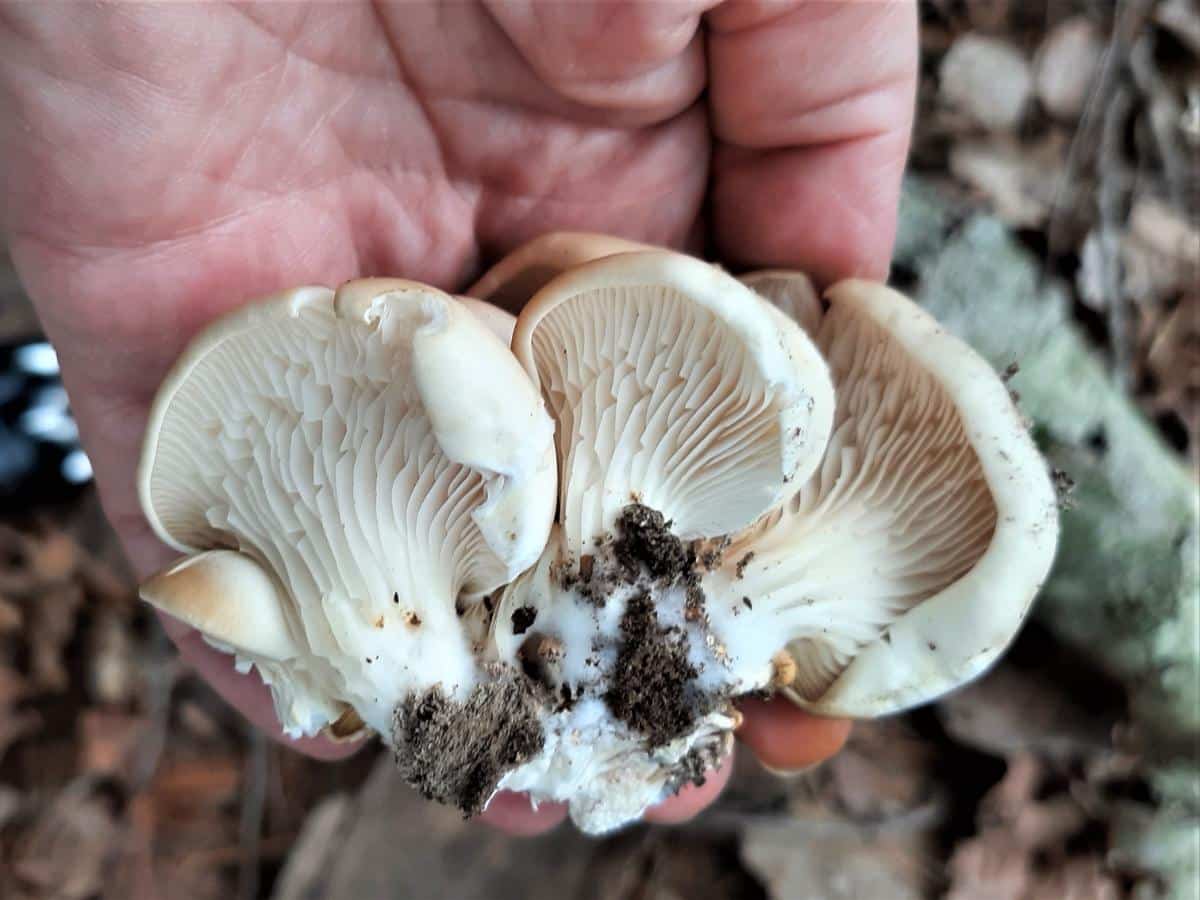
Giant Puffballs (Calvatia gigantea)
Giant Puffballs are large, round mushrooms that can grow quite large. They’re typically found in open fields or meadows and are best harvested when young and white throughout. These mushrooms have a mild flavor and can be sliced and cooked like a steak or used as a pizza base instead of a crust.
These mushrooms can grow to impressive sizes, sometimes reaching up to 70 cm (28 inches) in diameter. To identify a giant puffball, look for a smooth, white, ball-shaped fruiting body growing close to the ground in grassy areas, meadows, or deciduous forests. The exterior should be uniformly white and unmarked, with a texture similar to marshmallow or soft leather. When mature, the inside should be pure white and have a solid, consistent texture throughout.
It’s crucial to cut the mushroom in half to ensure there are no signs of gills, stems, or any other internal structures, as these would indicate a different, potentially dangerous species. Giant puffballs are edible when young, fresh, and pure white inside. As they age, the interior turns yellow and then brown. Finally, it becomes a mass of black spores that are released when the outer shell breaks open.

Wood Blewit (Clitocybe nuda)
Wood Blewits are beautiful purple mushrooms that can be found in deciduous and coniferous forests. They have a distinctive lilac color when young but fade to a bland tan as they age. Wood Blewits have a robust and earthy flavor and are often used in soups and stews.
These fungi typically have smooth, dome-shaped caps ranging from 2-6 inches in diameter. They are a beautiful purple-lilac when young but then fade to a tan or buff color as they mature. The gills underneath the cap are crowded and range from pale lilac to pinkish-brown. Wood blewits have a thick, sturdy stem that’s often bulbous at the base and shares the cap’s purple hue.
They have a pleasant, orange-juice-like smell and grow singularly or in clusters on the forest floor, often among leaf litter or in grassy areas near deciduous trees. While edible and prized by foragers, it’s crucial to accurately identify wood blewits, as they can be confused with some toxic purple mushrooms.

Cauliflower Mushroom (Sparassis crispa)
The Cauliflower Mushroom resembles its namesake vegetable with its wavy, leaf-like structure. It’s typically found at the base of coniferous trees and has a mild, nutty flavor. This mushroom is enjoyed for its unique texture and appearance.
This is a distinctive and easily recognizable fungus. It grows in large, intricate clusters that resemble a head of cauliflower. The fruiting body is typically 4-24 inches wide and composed of numerous flat, wavy, leaf-like branches that are cream to pale yellow in color. These branches are thin and fragile, with a texture similar to egg noodles.
The mushroom has a short, thick stem that’s often hidden within the mass of branches. When fresh, it emits a pleasant, slightly sweet aroma. Cauliflower mushrooms are usually found at the base of coniferous trees, particularly pines, in late summer and fall. Their unique appearance, specific location, and seasonality requirements make them a great mushroom for beginner foragers.

Wood Ear (Auricularia auricula-judae)
Wood ear mushrooms are an odd-looking and versatile fungus used in many cuisines, particularly in East Asian cooking. These mushrooms get their name from their distinctive appearance, which resembles a dark, wrinkled ear protruding from wood. Wood ear mushrooms have a gelatinous texture when fresh and a slightly crunchy consistency when dried and rehydrated.
These edible mushrooms are gelatinous, ear-shaped, and can range from dark brown to black in color. They typically grow on dead or dying wood, particularly elder trees, but can also be found on other hardwoods. The surface of wood ear mushrooms is smooth and slightly velvety when fresh and becomes more wrinkled and folded as they mature. Their size can vary from 1-3 inches in diameter.
When dry, they shrink considerably and become hard, but they quickly rehydrate when soaked in water, regaining their original texture. They are often used in soups, stir-fries, and salads, absorbing the flavors of the dishes they’re added to while providing a pleasant, chewy texture.

Lobsters (Hypomyces lactifluorum)
These vibrant orange-red mushrooms get their name from their striking resemblance to cooked lobster shells. Interestingly, they’re not a mushroom species on their own but rather the result of a parasitic fungus that infects and transforms other mushrooms, typically those from the Russula or Lactarius genera. This parasitic takeover alters the host mushroom’s appearance, texture, and flavor, creating a firm, meaty texture and a subtle seafood-like taste.
Lobster mushrooms are easily recognizable due to their distinctive appearance. These fungi typically measure 2 to 10 inches in width and can grow up to 12 inches tall. Their most striking feature is their bright orange to reddish-orange color, reminiscent of a cooked lobster shell. The surface is bumpy and irregular, often with white patches. Unlike typical mushrooms, lobster mushrooms lack gills; instead, they have a smooth or slightly wrinkled underside. The flesh is firm and white when cut. Look for them growing on the forest floor, often partially hidden by leaves or debris, in hardwood and mixed forests during late summer and fall.

Shrimp of the Woods (Entoloma abortivum)
Shrimp of the Woods earned its name due to its uncanny resemblance to a cluster of shrimp, with its pale, lumpy, and irregularly shaped fruiting bodies. These edible mushrooms result from a parasitic relationship between two different fungi: Entoloma abortivum and Armillaria species. The Entoloma abortivum fungus infects and deforms the Armillaria mushrooms, creating the distinctive “shrimp-like” appearance. Shrimp of the Woods is prized for its mild, seafood-like flavor and firm texture.
Shrimp of the woods fruiting bodies typically measure 1-4 inches in diameter and 1-3 inches in height. The mushroom has a misshapen, lumpy mass rather than a typical shape. Its color ranges from whitish to pale grayish-pink, often with a slightly mottled surface. The texture is firm and dense, similar to that of a marshmallow. When cut open, the interior reveals a solid, white flesh. Unlike many other mushrooms, shrimp of the woods lacks a clearly defined cap and stem structure.

Honey Mushrooms (Armillaria spp)
Honey mushrooms earned their common name from their honey-colored caps. These mushrooms grow in dense clusters at the base of trees or on decaying wood. They have pale yellow to brown caps, a distinct ring around the stem, and a white spore print. While appreciated for their edibility, they are notorious among gardeners and foresters for their parasitic nature. Honey mushrooms possess an extraordinary ability to spread underground through root-like structures called rhizomorphs, allowing them to infect and slowly kill living trees over vast areas, sometimes spanning several acres.
Honey mushrooms grow in clusters on wood. The caps range from 1 to 6 inches in diameter and are usually honey-colored but vary from pale yellow to reddish-brown. Their stems are 2 to 8 inches tall, often with a ring or collar just below the cap. The ringless honey mushroom doesn’t have this telltale ring around the stem but is recognizable by the other standard features.
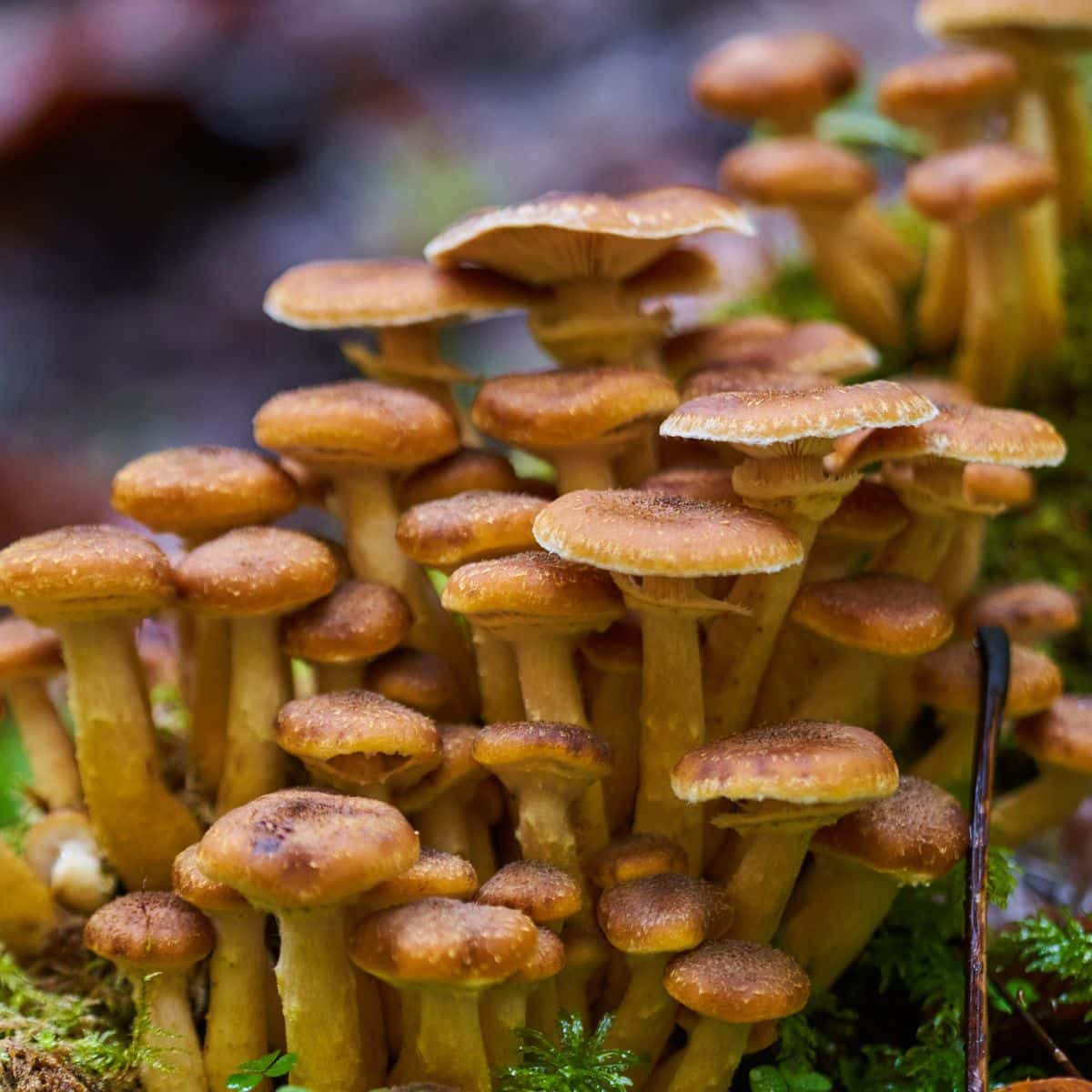
Hedgehogs (Hydnum repandum)
These edible mushrooms earn their common name from the unique, tooth-like projections that hang from the underside of their caps, resembling the spines of a hedgehog. The caps are typically pale to golden-yellow in color, with a smooth, slightly irregular surface, and range from 2 to 6 inches in diameter. These mushrooms grow low to the ground, often partially hidden by forest debris. Hedgehog mushrooms have a firm, dense texture and a mildly sweet, nutty flavor that becomes more peppery when cooked.
Hedgehog mushrooms are easily identifiable by their unique underside. Instead of gills or pores, they have pale, downward-pointing spines or “teeth” that are 1/8 to 1/4 inch long. The cap varies from rounded to flat, often with wavy edges. The stem is usually 1 to 3 inches tall and 1/2 to 1 inch thick, solid, and off-white to pale brown. When cut, the flesh is white and firm. These mushrooms often grow in clusters on the forest floor, particularly near oak, pine, or fir trees.

Black Staining Polypore (Meripilus giganteus)
This impressive polypore grows in clusters at the base of deciduous trees, particularly favoring beech and oak. Many guides say this species isn’t edible, but it is (and quite delicious!) when young. The key is to find it before it gets too big and tough. The flavor is robust and meaty.
The black-staining polypore has large, fan-shaped fruiting bodies that grow in overlapping clusters. These polypores typically measure 4 to 16 inches across. The upper surface is smooth and light brown to yellowish when young, darkening with age. The most notable feature is its tendency to stain black when bruised or cut. The pores are white to cream-colored when fresh. This polypore is usually found at the base of hardwood trees, particularly oaks, where it causes butt rot. Its flesh is white and fibrous when young but becomes tough and leathery with age.
Black staining polypores are often confused with hen of the woods because they look incredibly similar. They are the same color and grow in dense, overlapping clusters. The easiest way to tell them apart is to check for staining on the pores. Hen of the woods doesn’t stain black when handled.

Best Foraging Locations in the Southeast
The Southeast offers a diverse range of habitats for fall mushroom foraging, each with its own unique ecosystem that supports different species of fungi. Understanding these environments can significantly improve your mushroom hunting and increase your chances of finding edible mushrooms.
Oak Forests
Oak forests are a prime location for fall mushroom foraging in the Southeast. These woodlands provide an ideal habitat for many sought-after mushroom species, including hen of the woods, chicken of the woods, and black-staining polypores. Old-growth oak forests are prime, but any oak forest is worth searching.
Hardwood Stumps and Logs
Dead or dying hardwood trees, stumps, and logs are excellent spots to find a variety of edible mushrooms. Oyster mushrooms can be found growing in clusters on this decaying wood. They’re relatively easy to identify and can be spotted bursting out of the wood in small to large groups.
The lion’s mane is another mushroom to look out for on hardwood stumps. With its white, cascading waterfall spines, this unique fungus is easy to see against the hardwood. It’s even easier to spot once the trees lose their leaves and there is nothing to block them from sight.
Creek Beds and Damp Areas
Creek beds and other moist areas are hotspots for mushroom foraging in the Southeast. These damp environments provide the perfect conditions for many species to thrive.
Creek bottoms can be particularly productive early in the season for fall mushroom hunting. As the weather cools, saprophytic mushrooms like oysters often appear first in these colder, damper areas before spreading to warmer locations later in the season.

Foraging Techniques for Fall Mushrooms
Many autumn mushrooms, such as hen of the woods and oyster mushrooms, grow on trees or old wood. This makes them easier to spot and often requires less cleaning compared to ground-growing species.
For ground foraging, focus on areas with moist soil and plenty of organic matter. Look for mushrooms growing near the base of trees or in open fields. When foraging on trees, examine both living and dead wood, paying attention to stumps, logs, and standing trees.
Using Your Senses
Successful mushroom hunting relies heavily on using all your senses. Vision is crucial for spotting mushrooms, but other senses play important roles, too.
- Sight: Scan the forest floor and trees for distinctive shapes, colors, and textures that might indicate the presence of mushrooms.
- Touch: Gently handle mushrooms to assess their texture and firmness. This can help with identification and determining freshness.
- Smell: Many edible mushrooms have distinctive aromas. Familiarize yourself with the scents of common edible species in your area.
- Taste: While tasting should be done cautiously and only with expert guidance, some experienced foragers use taste as a tool for identification. However, remember that taste is not an indicator of edibility, as some poisonous mushrooms can taste pleasant.
Remember, the most important tool is knowledge. Familiarize yourself with the edible fall mushrooms in your area, their habitats, and any toxic lookalikes.
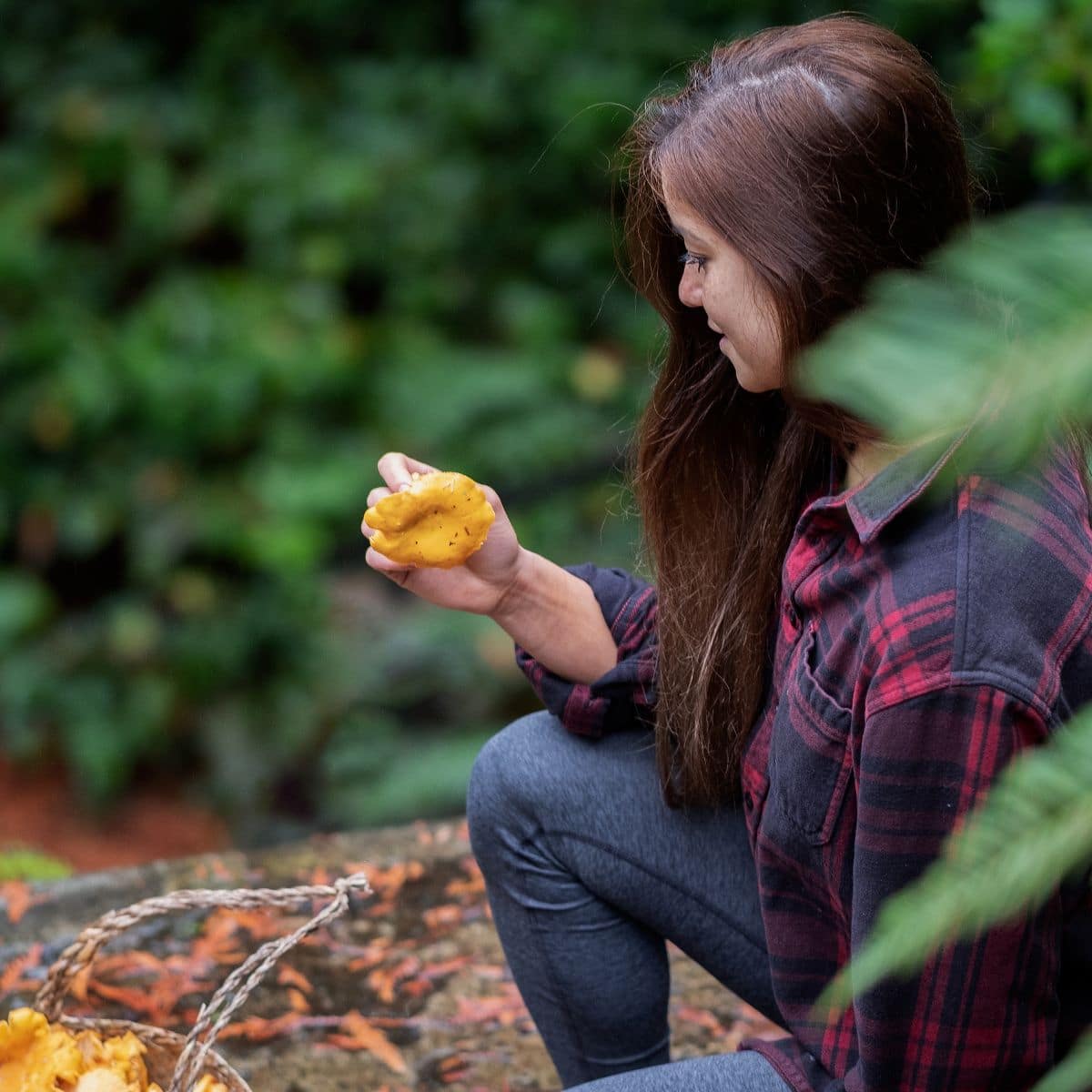
Foraging Resources
If you’re new to mushroom foraging, here are some great guides to get started: How To Be A Successful Mushroom Forager, Mushroom Foraging 101, and Mushroom Identification Pictures and Examples.
This guide to the best identification books by region will help you find the best guides for you.
Curious about winter foraging in other areas? Check out our guides for across the US.
- Fall mushroom foraging in New England
- Fall mushroom foraging in the Pacific Northwest
- Fall mushroom Foraging in the Midwest
- Fall mushroom Foraging in the Southwest

Common Questions About Mushroom Foraging
What types of mushrooms can be found during the fall season?
It depends on where you live. In the southeast, you can find chicken of the woods, lobsters, oysters, hen of the woods, wood ears, and lion’s mane, among others.
When is the ideal time for mushroom hunting?
The best months for mushroom hunting are from late September to late November. This is when the most number of edible species are fruiting. However, this isn’t the only time to hunt for mushrooms. There are species fruiting year-round, especially in the warmer southern states.
What are some recommended mushroom identification books for the Southeast United States?
For those foraging in the Southeast United States, seeking out a region-specific mushroom identification guide is ideal. This guide to The Best Mushroom Foraging Books by Region will help.





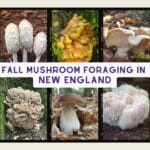


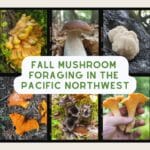
Leave a Reply